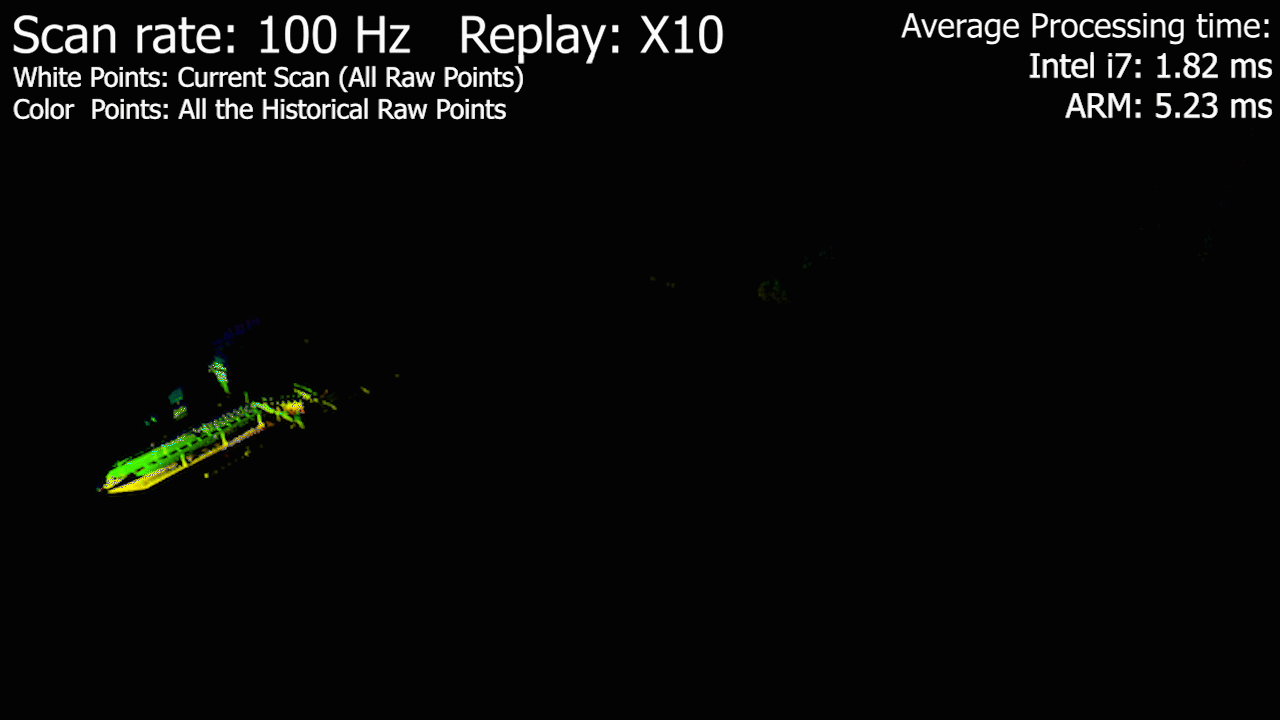- ikd-Tree: A state-of-art dynamic KD-Tree for 3D kNN search.
- IKFOM: A Toolbox for fast and high-precision on-manifold Kalman filter.
- UAV Avoiding Dynamic Obstacles: One of the implementation of FAST-LIO in robot's planning.
- R2LIVE: A high-precision LiDAR-inertial-Vision fusion work using FAST-LIO as LiDAR-inertial front-end.
- UGV Demo: Model Predictive Control for Trajectory Tracking on Differentiable Manifolds.
- FAST-LIO-SLAM: The integration of FAST-LIO with Scan-Context loop closure module.
- FAST-LIO-LOCALIZATION: The integration of FAST-LIO with Re-localization function module.
FAST-LIO (Fast LiDAR-Inertial Odometry) is a computationally efficient and robust LiDAR-inertial odometry package. It fuses LiDAR feature points with IMU data using a tightly-coupled iterated extended Kalman filter to allow robust navigation in fast-motion, noisy or cluttered environments where degeneration occurs. Our package address many key issues:
- Fast iterated Kalman filter for odometry optimization;
- Automaticaly initialized at most steady environments;
- Parallel KD-Tree Search to decrease the computation;
Related video: FAST-LIO2, FAST-LIO1, FAST-LIO2 + Scan-context Loop Closure
Pipeline:
New Features:
- Incremental mapping using ikd-Tree, achieve faster speed and over 100Hz LiDAR rate.
- Direct odometry (scan to map) on Raw LiDAR points (feature extraction can be disabled), achieving better accuracy.
- Since no requirements for feature extraction, FAST-LIO2 can support may types of LiDAR including spinning (Velodyne, Ouster) and solid-state (Livox Avia, Horizon, MID-70) LiDARs, and can be easily extended to support more LiDARs.
- Support external IMU.
- Support ARM-based platforms including Khadas VIM3, Nivida TX2, Raspberry Pi 4B(8G RAM).
Related papers:
FAST-LIO2: Fast Direct LiDAR-inertial Odometry
FAST-LIO: A Fast, Robust LiDAR-inertial Odometry Package by Tightly-Coupled Iterated Kalman Filter
Contributors
Wei Xu 徐威,Yixi Cai 蔡逸熙,Dongjiao He 贺东娇,Fangcheng Zhu 朱方程,Jiarong Lin 林家荣,Zheng Liu 刘政, Borong Yuan
Ubuntu >= 16.04
For Ubuntu 18.04 or higher, the default PCL and Eigen is enough for FAST-LIO to work normally.
ROS >= Melodic. ROS Installation
PCL >= 1.8, Follow PCL Installation.
Eigen >= 3.3.4, Follow Eigen Installation.
Follow livox_ros_driver Installation.
Remarks:
- Since the FAST-LIO must support Livox serials LiDAR firstly, so the livox_ros_driver must be installed and sourced before run any FAST-LIO luanch file.
- How to source? The easiest way is add the line
source $Licox_ros_driver_dir$/devel/setup.bashto the end of file~/.bashrc, where$Licox_ros_driver_dir$is the directory of the livox ros driver workspace (should be thews_livoxdirectory if you completely followed the livox official document).
Clone the repository and catkin_make:
cd ~/$A_ROS_DIR$/src
git clone https://github.com/hku-mars/FAST_LIO.git
cd FAST_LIO
git submodule update --init
cd ../..
catkin_make
source devel/setup.bash
- Remember to source the livox_ros_driver before build (follow 1.3 livox_ros_driver)
- If you want to use a custom build of PCL, add the following line to ~/.bashrc
export PCL_ROOT={CUSTOM_PCL_PATH}
Please make sure the IMU and LiDAR are Synchronized, that's important.
Connect to your PC to Livox Avia LiDAR by following Livox-ros-driver installation, then
cd ~/$FAST_LIO_ROS_DIR$
source devel/setup.bash
roslaunch fast_lio mapping_avia.launch
roslaunch livox_ros_driver livox_lidar_msg.launch
- For livox serials, FAST-LIO only support the data collected by the
livox_lidar_msg.launchsince only itslivox_ros_driver/CustomMsgdata structure produces the timestamp of each LiDAR point which is very important for the motion undistortion.livox_lidar.launchcan not produce it right now. - If you want to change the frame rate, please modify the publish_freq parameter in the livox_lidar_msg.launch of Livox-ros-driver before make the livox_ros_driver pakage.
mapping_avia.launch theratically supports mid-70, mid-40 or other livox serial LiDAR, but need to setup some parameters befor run:
Edit config/avia.yaml to set the below parameters:
- LiDAR point cloud topic name:
lid_topic - IMU topic name:
imu_topic - Translational extrinsic:
extrinsic_T - Rotational extrinsic:
extrinsic_R(only support rotation matrix)
- The extrinsic parameters in FAST-LIO is defined as the LiDAR's pose (position and rotation matrix) in IMU body frame (i.e. the IMU is the base frame). They can be found in the official manual.
- FAST-LIO produces a very simple software time sync for livox LiDAR, set parameter
time_sync_ento ture to turn on. But turn on ONLY IF external time synchronization is really not possible, since the software time sync cannot make sure accuracy.
Step A: Setup before run
Edit config/velodyne.yaml to set the below parameters:
- LiDAR point cloud topic name:
lid_topic - IMU topic name:
imu_topic(both internal and external, 6-aixes or 9-axies are fine) - Line number (we tested 16, 32 and 64 line, but not tested 128 or above):
scan_line - Translational extrinsic:
extrinsic_T - Rotational extrinsic:
extrinsic_R(only support rotation matrix)
- The extrinsic parameters in FAST-LIO is defined as the LiDAR's pose (position and rotation matrix) in IMU body frame (i.e. the IMU is the base frame).
Step B: Run below
cd ~/$FAST_LIO_ROS_DIR$
source devel/setup.bash
roslaunch fast_lio mapping_velodyne.launch
Step C: Run LiDAR's ros driver or play rosbag.
Remarks:
- We will produce some velodyne datasets which is already transfered to Rosbags, please wait for a while.
Set pcd_save_enable in launchfile to 1. All the scans (in global frame) will be accumulated and saved to the file FAST_LIO/PCD/scans.pcd after the FAST-LIO is terminated. pcl_viewer scans.pcd can visualize the point clouds.
Tips for pcl_viewer:
- change what to visualize/color by pressing keyboard 1,2,3,4,5 when pcl_viewer is running.
1 is all random
2 is X values
3 is Y values
4 is Z values
5 is intensity
Download avia_indoor_quick_shake_example1 or avia_indoor_quick_shake_example2 and then
roslaunch fast_lio mapping_avia.launch
rosbag play YOUR_DOWNLOADED.bag
Download avia_hku_main building_mapping and then
roslaunch fast_lio mapping_avia.launch
rosbag play YOUR_DOWNLOADED.bag
In order to validate the robustness and computational efficiency of FAST-LIO in actual mobile robots, we build a small-scale quadrotor which can carry a Livox Avia LiDAR with 70 degree FoV and a DJI Manifold 2-C onboard computer with a 1.8 GHz Intel i7-8550U CPU and 8 G RAM, as shown in below.
The main structure of this UAV is 3d printed (Aluminum or PLA), the .stl file will be open-sourced in the future.
Thanks for LOAM(J. Zhang and S. Singh. LOAM: Lidar Odometry and Mapping in Real-time), Livox_Mapping, LINS and Loam_Livox.





